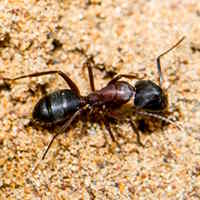
ARGENTINE ANTS
Identification, Facts, & Control
Latin Name
Linepithema humile (formerly Iridomyrmex humilis)
Appearance
_-_Flickr_-_S._Rae_480x480.jpg) Light to a dark brown. Workers: 2.2 to 2.8 mm long. Queens: 4 to 6 mm
Light to a dark brown. Workers: 2.2 to 2.8 mm long. Queens: 4 to 6 mm
The Argentine Ant {Iridomymex humilis) - most likely made its entry into the United States into New Orleans by way of the coffee ships from Brazil in the late 1800's. The worker or sterile female is 2.2 to 2.8 mm long, but it may appear larger when the abdomen is distended with food. In color it varies from a light to a dark brown, with the thorax, scapes, and legs somewhat lighter. The queen is brownish and from 4 to 6 mm in length and is by far the largest ant in the colony. There is usually more than one queen in the colony and a way of finding this out is to pour a 20 oz. bottle of water over a nesting site and observe within a short time, the workers carrying their young with their mandibles and very often a number of queens will emerge.
Though small and easy to kill, the workers are quite aggressive and will eliminate other ants in their path. They seldom swarm; but will move their colonies with great frequency - for example: if the ground becomes too dry, hot, wet, or too cold. They may move indoors in the winter or when it is too dry or too wet outdoors. They prefer sweets over all other foods. They also enjoy fruit, honeydew, insects, meats, and seeds.
The Argentine Ant has successfully survived and thrived in the United States for the following reasons:
- They are friendly to one another (even the queens), unlike ants of most other species.
- The ants are very adaptable and nest in a variety of conditions.
- In an area where there is an infestation, the widely separated galleries of the ants eventually come together (interconnect). In addition, there are a great number of queens in an infested area, having a high reproductive potential, and therefore the ability to build large colonies.
- A common pathway for these ants is below the carpeting between the carpet tack strip and baseboard.
- They feed on the secretions produced by aphids and scale insects which are in abundance at the bases and trunks of trees.
- Sweet syrup baits work well due to the ants "sweet tooth". Surfaces should be treated with a residual insecticide around the perimeter of the area outside the nest. The theory behind poisoned baits is that when the queens are killed or made ill, the reproductive capacity of the colony is diminished and therefore there will eventually be a curtailment in the number of workers.
- If no evidence has been found of Argentine ants on the exterior foundation, walkways, or garage in a single family dwelling with a raised foundation. The next best area to look in finding the infestation would be to check out the substructure.
- Treating trails of these ants will have little effect on eliminating the infestation because there are only a small number of ants away from the nest at any given time.
- If a nest has been found to exist in a wall void the treatment that would result in the insect's eradication and have the longest residual effect would be dust.
- Treatment should be performed during the winter to early spring because this is the time when these ants are most active.
- After the exterior of a structure has been treated, a second treatment should be performed by the same pesticide by the interval indicated on the pesticide label.
- Baits should be used to control an interior infestation only after a spray application.
Having trouble with Pests?
Give us a call: 661-645-6855
Or have Traffic contact you today and get a FREE estimate for:
Your Neighborhood Bug Guys!
Traffic Pest Solutions (LA)
15828 Toscana Ct.
Santa Clarita, CA 91387
Phone: (661) 645-6855Santa Clarita, CA 91387

_-_Flickr_-_S._Rae_Thumb.jpg) Argentine Ants
Argentine Ants![Formicidae_Solenopsis_invicta by Hugo A. Quintero G. from Medellin, Colombia [CC BY 2.0 (https://creativecommons.org/licenses/by/2.0)]](/images/temp/ants/Formicidae_Solenopsis_invicta_200x200.jpg) Fire Ants
Fire Ants![Katja Schulz from Washington, D. C., USA [CC BY 2.0 (https://creativecommons.org/licenses/by/2.0)]](/images/temp/ants/Carpenter_Ant_-_Flickr_-_treegrow_(2)_200x200.jpg) Carpenter Ants
Carpenter Ants![Harvester Ants - Mike Lewinski from Tres Piedras, NM, United States [CC BY 2.0 (https://creativecommons.org/licenses/by/2.0)]](/images/temp/ants/Pogonomyrmex_harvester_ants_(7974355023)_200x200.jpg) Harvester Ants
Harvester Ants![Odorous House Ants - Brian Gratwicke [CC BY 2.0]](/images/temp/ants/Odorous_house_ant_(17434366603)_200_200.jpg) Odorous House Ants
Odorous House Ants![Pavement Ants - Ryan Hodnett [CC BY-SA 4.0 (https://creativecommons.org/licenses/by-sa/4.0)]](/images/temp/ants/Immigrant_Pavement_Ant_(Tetramorium_immigrans)_-_London,_Ontario_200x200.jpg) Pavement Ants
Pavement Ants![Pharaoh Ants - Julian.szulc [CC BY 3.0 (https://creativecommons.org/licenses/by/3.0)]](/images/temp/ants/Monomorium_pharaonis_worker_with_sugar_crystal_200x200.jpg) Pharaoh Ants
Pharaoh Ants![Thief Ants - Mangodreads [CC BY-SA 4.0 (https://creativecommons.org/licenses/by-sa/4.0)]](/images/temp/ants/North_American_Thief_Ant_200x200.jpg) Thief Ants
Thief Ants Velvety Tree Ants
Velvety Tree Ants